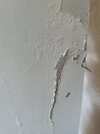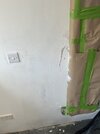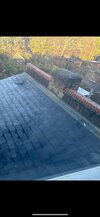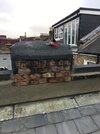Here’s the clues for my mystery. Probably a dilemma solved all day long for you experts but I appreciate your help.
Next door neighbour knocked last year. He had damp spots on his wall. His builder injected wall for rising damp. Classic 1900 Victorian in london-the type with bay windows. The damp was in his kitchen extension. Our kitchens back onto each other. Let the builder in to check my side but I had units in front.
Fast forward 8 months. Had kitchen renovated. Builders pulled down plaster covering the bricks so as to run new electrics. The wall that backs onto neighbour was SOAKED behind the plaster. Only possible solution, old chimney breast on roof. Got a bloke in to repair all the rendering and flashing up there. Looks like a good job.
Here’s the problem, builder was obviously on a time scale and refused to pause job and let bricks dry out. He rendered and painted using contract (or is it contact) trade matt. I could see within a week the wall was wet. Got a moister gauge (been stalking the forums before I posted so knew to buy one) and we’ve had some pretty wet days but the "classic" type damp patches seemed to fade. So it’s obvious what I’m about to tell you but my approach to solve the problem is out of my wheel house.
Fast forward 2 months, big damp patches dried out but I started getting bubbles in certain areas of the wall. I took pics when they first came up and pics today. Texture behind bubbles and flakes are dry. Moisture monitor says water is a lot less than when problem first happened. I’m guessing this problem is due to either residual water or builders not letting wall dry out. I haven't started using the kitchen yet so condensation isn't a factor. The brown wrapping is over a radiator which I have isolated. I wrapped it so I could spray damp block when the problem was tiny (waste of time) It's also a read herring as the problem is also away from the rad but this is the worst section. The rad isn't leaking, boiler pressure is steady with no drops
Now you have all the clues, can someone kindly tell me what I should do to stop this keep happening? Thank you, you decoration detectives you!
Next door neighbour knocked last year. He had damp spots on his wall. His builder injected wall for rising damp. Classic 1900 Victorian in london-the type with bay windows. The damp was in his kitchen extension. Our kitchens back onto each other. Let the builder in to check my side but I had units in front.
Fast forward 8 months. Had kitchen renovated. Builders pulled down plaster covering the bricks so as to run new electrics. The wall that backs onto neighbour was SOAKED behind the plaster. Only possible solution, old chimney breast on roof. Got a bloke in to repair all the rendering and flashing up there. Looks like a good job.
Here’s the problem, builder was obviously on a time scale and refused to pause job and let bricks dry out. He rendered and painted using contract (or is it contact) trade matt. I could see within a week the wall was wet. Got a moister gauge (been stalking the forums before I posted so knew to buy one) and we’ve had some pretty wet days but the "classic" type damp patches seemed to fade. So it’s obvious what I’m about to tell you but my approach to solve the problem is out of my wheel house.
Fast forward 2 months, big damp patches dried out but I started getting bubbles in certain areas of the wall. I took pics when they first came up and pics today. Texture behind bubbles and flakes are dry. Moisture monitor says water is a lot less than when problem first happened. I’m guessing this problem is due to either residual water or builders not letting wall dry out. I haven't started using the kitchen yet so condensation isn't a factor. The brown wrapping is over a radiator which I have isolated. I wrapped it so I could spray damp block when the problem was tiny (waste of time) It's also a read herring as the problem is also away from the rad but this is the worst section. The rad isn't leaking, boiler pressure is steady with no drops
Now you have all the clues, can someone kindly tell me what I should do to stop this keep happening? Thank you, you decoration detectives you!
Attachments
Last edited:








